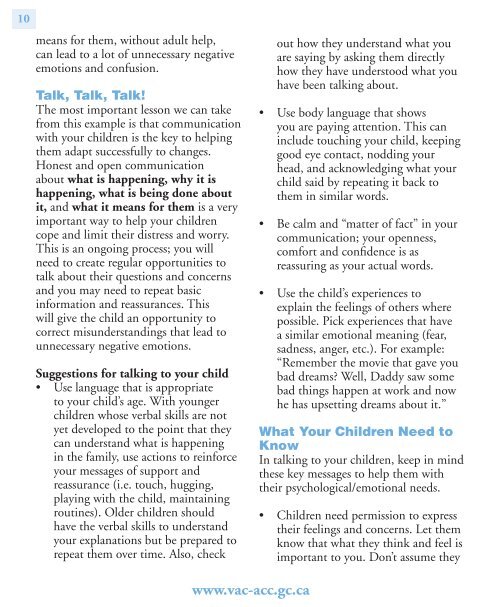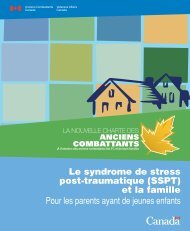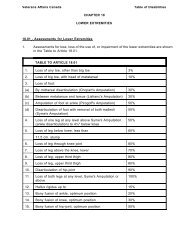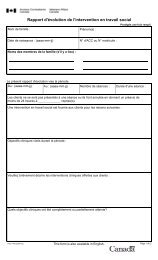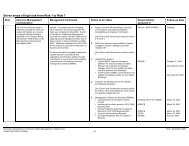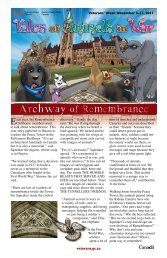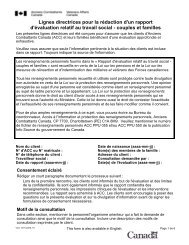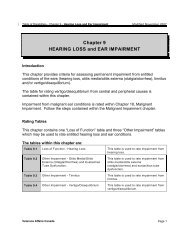Post-Traumatic Stress Disorder (PTSD) and the Family for Parents ...
Post-Traumatic Stress Disorder (PTSD) and the Family for Parents ...
Post-Traumatic Stress Disorder (PTSD) and the Family for Parents ...
Create successful ePaper yourself
Turn your PDF publications into a flip-book with our unique Google optimized e-Paper software.
10<br />
means <strong>for</strong> <strong>the</strong>m, without adult help,<br />
can lead to a lot of unnecessary negative<br />
emotions <strong>and</strong> confusion.<br />
Talk, Talk, Talk!<br />
The most important lesson we can take<br />
from this example is that communication<br />
with your children is <strong>the</strong> key to helping<br />
<strong>the</strong>m adapt successfully to changes.<br />
Honest <strong>and</strong> open communication<br />
about what is happening, why it is<br />
happening, what is being done about<br />
it, <strong>and</strong> what it means <strong>for</strong> <strong>the</strong>m is a very<br />
important way to help your children<br />
cope <strong>and</strong> limit <strong>the</strong>ir distress <strong>and</strong> worry.<br />
This is an ongoing process; you will<br />
need to create regular opportunities to<br />
talk about <strong>the</strong>ir questions <strong>and</strong> concerns<br />
<strong>and</strong> you may need to repeat basic<br />
in<strong>for</strong>mation <strong>and</strong> reassurances. This<br />
will give <strong>the</strong> child an opportunity to<br />
correct misunderst<strong>and</strong>ings that lead to<br />
unnecessary negative emotions.<br />
Suggestions <strong>for</strong> talking to your child<br />
• Use language that is appropriate<br />
to your child’s age. With younger<br />
children whose verbal skills are not<br />
yet developed to <strong>the</strong> point that <strong>the</strong>y<br />
can underst<strong>and</strong> what is happening<br />
in <strong>the</strong> family, use actions to rein<strong>for</strong>ce<br />
your messages of support <strong>and</strong><br />
reassurance (i.e. touch, hugging,<br />
playing with <strong>the</strong> child, maintaining<br />
routines). Older children should<br />
have <strong>the</strong> verbal skills to underst<strong>and</strong><br />
your explanations but be prepared to<br />
repeat <strong>the</strong>m over time. Also, check<br />
out how <strong>the</strong>y underst<strong>and</strong> what you<br />
are saying by asking <strong>the</strong>m directly<br />
how <strong>the</strong>y have understood what you<br />
have been talking about.<br />
• Use body language that shows<br />
you are paying attention. This can<br />
include touching your child, keeping<br />
good eye contact, nodding your<br />
head, <strong>and</strong> acknowledging what your<br />
child said by repeating it back to<br />
<strong>the</strong>m in similar words.<br />
• Be calm <strong>and</strong> “matter of fact” in your<br />
communication; your openness,<br />
com<strong>for</strong>t <strong>and</strong> confidence is as<br />
reassuring as your actual words.<br />
• Use <strong>the</strong> child’s experiences to<br />
explain <strong>the</strong> feelings of o<strong>the</strong>rs where<br />
possible. Pick experiences that have<br />
a similar emotional meaning (fear,<br />
sadness, anger, etc.). For example:<br />
“Remember <strong>the</strong> movie that gave you<br />
bad dreams Well, Daddy saw some<br />
bad things happen at work <strong>and</strong> now<br />
he has upsetting dreams about it.”<br />
What Your Children Need to<br />
Know<br />
In talking to your children, keep in mind<br />
<strong>the</strong>se key messages to help <strong>the</strong>m with<br />
<strong>the</strong>ir psychological/emotional needs.<br />
• Children need permission to express<br />
<strong>the</strong>ir feelings <strong>and</strong> concerns. Let <strong>the</strong>m<br />
know that what <strong>the</strong>y think <strong>and</strong> feel is<br />
important to you. Don’t assume <strong>the</strong>y<br />
www.vac-acc.gc.ca


